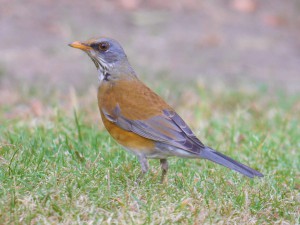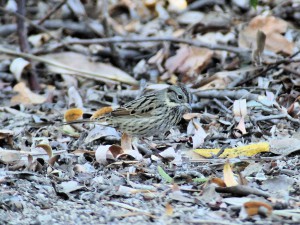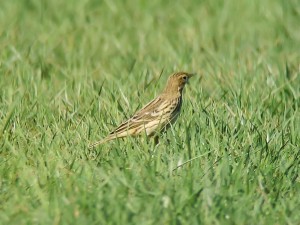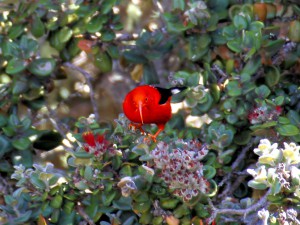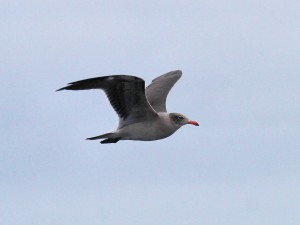Last weekend, we drove out to Twentynine Palms, CA to look for a Rufous-backed Robin previously reported there. The bird had been present for at least a week on the lush grounds of the 29 Palms Inn resort. This resort is a 70-acre oasis of greenery and water for wildlife in the middle of the Mojave Desert, and the owners and operators of the inn are very birder friendly. Thus, it consistently draws in wildlife of all kinds from the surrounding desert. The 29 Palms Inn sits close to Joshua Tree National Park, in extreme south central San Bernardino County, CA. Continue reading
Monthly Archives: October 2014
Lincoln’s Sparrow
The Lincoln’s Sparrow (Melospiza lincolnii) is a smallish member of the same genus as the familiar Song Sparrow (Melospiza melodia). Lincoln’s Sparrows have nearly as broad a distribution as Song Sparrows. Lincoln’s Sparrows only appear in southeastern states like Virginia, the Carolinas, Georgia and Florida during migration. They are migratory, breeding in far northern Canada and at upper elevations of the Rocky and Sierra Nevada ranges. Thus, Lincoln’s Sparrows abandon much of their listed range except as passage migrants.
Here in southern California, we see these beautiful little sparrows primarily in winter. Lincoln’s Sparrows do breed as nearby as the San Gabriel and San Bernardino Mountains. The winter range of Lincoln’s Sparrow stretches almost all the way south to Panama. Sometimes you can find upwards of 20-30 Lincoln’s Sparrows in a large, loose winter flock.
Continue reading
Zeiss Victory SF Binoculars
Zeiss Victory SF Binoculars
Some of you may already have heard about the Victory SF binoculars, the new high-end binocular from Zeiss. Zeiss added a new binocular to the Victory line: the SF. Victory SF binoculars are a completely re-imagined roof prism design. Zeiss now says that Victory SFs will be available for purchase in January, 2015.
Conveniently, we have first-hand experience with this binocular. I participated in the official Zeiss Victory SF Experience press event in Europe in June, 2014 and got to bird with a pre-production Victory SF for a week (For a travelogue of the press event birding, see Zeiss Victory SF Experience Tour, Part 1, Part 2, Part 3, Part 4). It’s a dirty job, but someone had to do it, so I happily took one for the team! We also had a pre-production Victory SF model in the store for a week this past August. Even though we haven’t seen a production model Victory SF, we can tell you already that it’s a spectacular nature viewing binocular. Continue reading
Red-throated Pipits Return to SoCal
Migration of Red-throated Pipits
One of the most amazing migratory flights is that of the Red-throated Pipit Anthus cervinus. This pipit breeds primarily in eastern Europe and Asia, almost completely above the Arctic Circle, and on the Kamchatka Peninsula. There are also some breeding grounds in Alaska’s northwest coast, Bering Sea islands, and possibly also in the Yukon.
Most Red-throated Pipits migrate down the western Pacific and winter in China and as far south as Australia. Some of the more eastern breeders take a more easterly route. These 6-inch passerines fatten up on the islands in the Bering Sea and then head off on a 3,000 mile flight across the Pacific Ocean to the California coast. While annual each October in southern California in small numbers, mostly on sod farms, Red-throated Pipits are almost unheard of much north of the San Francisco Bay Area. This tells us that they rarely follow land and fly straight across the ocean. The Red-throated Pipits that migrate through SoCal winter in Baja California. eBird records show them wintering near La Paz, Baja California Sur, Mexico. Continue reading
‘I’iwi (Scarlet Hawaiian Honeycreeper)
‘I’iwi distribution
The ‘I’iwi (pronounced ee-EE-vee) is an endemic Hawaiian honeycreeper. We recently photographed this spectacular scarlet colored bird on Maui. It was once widely distributed throughout the Hawaiian Islands. The big island of Hawai’i accounts for 90% of today’s their population. Most of the remaining population in Eastern Maui and Kaua’i. Very small groups of this bird are also present on the islands of Oahu and Moloka’i but their numbers are extremely low (below 50 birds). Continue reading
A Fall Pelagic Trip Out of Dana Point
I recently took the fall pelagic birding trip out of Dana Point Harbor. Recent sightings of a Red-billed Tropicbird in the Santa Barbara Channel gave us hope. Hurricane systems south of us off the coast of Baja suggested that the fall pelagic might produce great birds. There had been greater than usual numbers of Craveri’s Murrelets in the channel. Many people were on the boat specifically looking for that species. Plus, September is the peak of Blue Whale occurrence in the channel. We knew beforehand that cetaceans rather than birds might dominate this trip. In the end, the trip met all of those expectations. Well, except for the tropicbird… Rats! Continue reading

